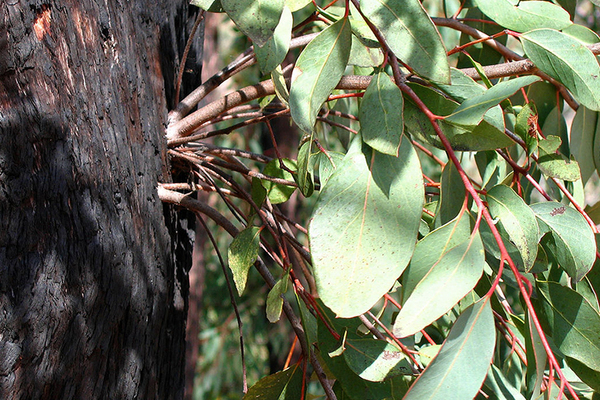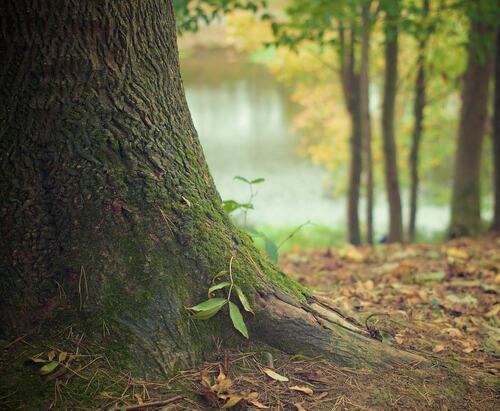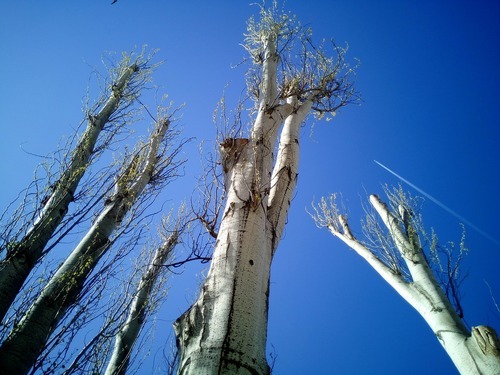Identifying and Managing Tree Suckers: Essential Tips for Healthy Growth

Photo: Wikimedia Commons
Understanding Tree Suckers and Sprouts
Epicormic sprouts, also known as "suckers" or "watersprouts," are growths that appear from dormant buds on an existing tree branch or trunk.
A tree of nearly any size can break out heavily in epicormic sprouts. Unlike vegetative buds and flower buds, epicormic sprouts are very small, usually embedded in the bark, and have a "strand" connection to the pith. As the tree grows in diameter, the strands increase in length, allowing the bud to survive and sprout whenever conditions are right.
The Biology of Suckers

Suckers Forming at the Base of a Tree - Image by Dave Meier from Pixabay
Suckers arise from dormant buds, which are usually small and embedded in the bark of the tree. These buds remain inactive until they receive signals from the tree that it's time to grow. This can happen when the tree is stressed or when conditions are particularly favorable for growth. The strands connecting these buds to the tree’s pith grow along with the tree, ensuring their survival until they are activated.
Factors Influencing Sucker Growth
Several factors can trigger the growth of suckers, including tree pruning, damage to the tree, or environmental stressors like drought or severe weather. Trees naturally produce a growth-regulating hormone that inhibits sucker growth, but if a tree is weakened or its normal growth is disrupted, this hormonal balance can be disturbed, leading to prolific sucker development.
Symptoms and Development
Dormant bud growth is controlled by a natural "growth regulator" made by the developing terminal buds in a healthy and vigorous crown. Unmanaged small-crowned, crowded trees in an understory or in an overstory do not produce enough regulators, so the buds break dormancy and sprout. Some intermediate and codominant trees do not put out epicormic sprouts until right after a stand is first thinned. Then, the sprouts receiving the most light often grow rapidly into large limbs that can reduce the quality of the branch or trunk.
A Fallen Beech Tree Forms Suckers at the Breakage Point - Photo: catskillforest.org
Different species of trees produce different quantities of sprouts—oaks create a much larger quantity than ash trees create. Additionally, evergreens produce very few suckers in comparison. In most situations, suckers tend to form on newer trees or shrubs. In species of aspen and poplar, they may form at some distance from the tree and are a natural process of reproduction.
There are many reasons that cause sprouts to appear, such as being newly exposed to sunlight. In urban areas, however, sprouts are a symptom of a stressed tree. Perhaps the tree experienced severe dieback due to winter weather, drought, or salt spray. These events often produce many such sprouts as a means of compensating for the loss of leaf surface due to the stress or injury. Suckers can also appear at the base of a tree. This type of sucker is usually found in plants that tend to form clumps of woody stems, such as lilac, rather than a single stem.
Management and Control of Tree Suckers

Watersprouts Forming on Topped Trees - Image by Patricia Maine Degrave on Pixabay
Effective management of tree suckers is essential for maintaining the health and appearance of your trees. Frequent monitoring and timely intervention can prevent suckers from draining energy from the main tree, thus preserving the tree's resources for its health and growth.
Pruning Techniques
Regular pruning is an effective method to control sucker growth. It’s important to use proper techniques to avoid causing stress or damage to the tree, which can exacerbate the problem. Removing suckers as soon as they are detected can also help minimize their impact on the tree’s overall health.
Best Practices for Sucker Prevention
To prevent the formation of suckers, ensure that your trees are healthy and not under stress. Adequate watering, proper fertilization, and ensuring that the trees are not planted too deeply can all help maintain the tree’s natural hormonal balance, which discourages sucker growth. Additionally, careful pruning that does not overstimulate the tree is crucial.
A standard—but not recommended—practice to improve the aesthetics of a tree with suckers is to remove sprout growth either partially or completely to the tips of the branches. This process is referred to in arboriculture as "lion-tailing," which can cause stress in the tree. Lion-tailed branches have a very high tendency to break under heavy winds, as the leaves are all on the tip instead of being spread out along the branch where they can better deal with wind pressure. "Topping" is another extreme pruning technique that leads to excessive suckers.
Thinning a tree too much for the first time may cause a flush of epicormic sprouts. It is important to note that when epicormic sprouts are removed, more sprouts will grow, as the tree needs tissue that uses sunlight to fuse nutrients from carbon dioxide and water to compensate for the wound from the initial removal. Essentially, the purpose of removal is defeated. The best practice is to remove a small percentage of the weaker sprouts growing in undesirable places and permit the rest to develop and self-regulate. Some sprouts will be dominant, eventually making the tissue resemble a branch.
Prevention is Key
Keeping a tree healthy is the best method to control epicormic sprouts. The easiest method of control is the frequent pruning of suckers found at the base of a tree. Excessive suckering can be prevented after trees are cut down with the use of a glyphosate herbicide on the freshly cut stumps. The herbicide does not work well to control suckers on old stumps.
Conclusion

An Expert with Arborist Now Correctly Prunes a Tree to Prevent Issues
Understanding the growth patterns and triggers for suckers and epicormic sprouts is key to effective tree care. Arborist Now provides expert tree care services tailored to the unique needs of trees in the San Francisco Bay Area. By employing best practices in tree health maintenance and sucker control, we help ensure that your trees remain beautiful and healthy.
For professional advice and tree care services, contact Arborist Now. We can help you implement a plan to regularly maintain the trees on your property and reduce the possibility of unnecessary tree removal. We're dedicated to enhancing the urban forest of San Francisco and ensuring the longevity and beauty of your trees.
Originally published on March 28, 2017.






